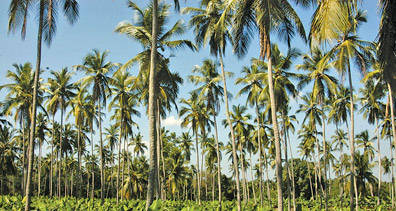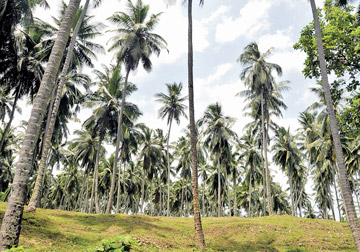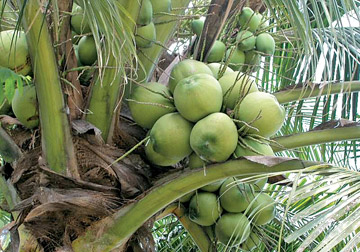Value addition will boost coconut industry
Dr N Yogaratnam
Total world production of coconut increased substantially from 35
million tonnes around 1980 to almost 50 million tonnes recently. Yet
this industry in Sri Lanka is in crisis today. The farm gate price has
shot up from around Rs 18 per nut to about Rs 35 to Rs 40 per nut and
even higher at Rs 65 per nut in urban areas.
|

Spinning, weaving and matting of coir employs large numbers
of people in the south of India and Sri Lanka. |
Coconut production in the country has gone down from 2,909 million
nuts in 2008 to 2762 million nuts in 2009, a drop of 147 million nuts.
The production in January to October 2010 had been 2,068 million nuts
as against 2,478 million nut in the same period in 2009, a reduction of
16.5%, although the cropping potential is in the region of 3500 million
nuts per year.
Yield varies from region to region (3500 to 6000 nuts/ha/year), which
is due to a number of factors; weather and fertilizer use and the lag
period for response may be 3 to 4 years.
One tree may yield on average 70 to 100 nuts to a maximum of 150 nuts
per year. The kernel (copra, coco-water and shell) comprises 65 per cent
of total weight, while the husk contributes 35 per cent.
Therefore, medium to long-term strategies should be in place to avert
crisis situations, such as that is seen now.
Value addition
Sri Lanka has become as one of the leading processors of what had
previously been considered a waste product into a form suitable for
horticultural use. While other sources may be available, companies in
Sri Lanka have been investing heavily in an infrastructure to guarantee
consistency and quality of the products, though this still lacks
perfection and exploitation of its vast potential.
Coir
Coir fibres are extracted from the husks surrounding the coconut . In
most areas coir is a by-product of copra production, and the husks are
left on the fields as a mulch or used as fertilizer because of high
potash content.
|

Sri Lanka has become one of the leading processors of what
had previously been considered a waste product into a form
suitable for horticultural use. |
India and Sri Lanka are the main countries where coir is extracted by
traditional methods for the commercial production of a variety of
products, including brushes and brooms, ropes and yarns for nets and
bags and mats, and padding for mattresses.
However, worldwide only a small part of the fibres available are
currently used for these purposes. The average fibre yield is dependent
on geographical area and the variety of the coconut tree.
In Sri Lanka and south India , for example, where the best quality
fibres are produced the average yield is 80 to 90 g fibre per husk.
Caribbean husks, by contrast, are relatively thick and may yield up to
150 g of fibre.
Husks are composed of 70 per cent pith and 30 per cent fibre on a dry
weight basis. The ratio of yield of long, medium and short fibre,
respectively, is on average 60:30:10. The total world production of coir
fibre (included short fibres) is estimated to be in the range of five
and six million tonnes per year.
Only a small part (less than 10 per cent) of this potential enters
commercial trade. Continuous expanding production of brown fibre reached
216 000 tonnes (70 per cent India, 27 per cent Sri Lanka) , while white
fibre production (again, mainly in India) has remained stable at 125 000
tonnes.
Coir markets
Coir has faced a declining market for traditional products in recent
decades. Despite their comparatively low trade value, the fibres provide
significant economic support to populations in specific areas of the
producing countries.
|

The coconut industry in Sri Lanka is in crisis today |
Women in these areas are particularly dependent on coir production
for their livelihood.
Traditionally, coir has been processed into a range of products such
as yarns for the production of floor coverings, mats and matting,
cordage and nets, bristle fibres for brooms and brushes, and for use
with domestic mattress and upholstery industries.
These markets have been dwindling in recent years due to strong
competition from synthetic products.
However, there is a firm trend in the industrial countries towards
the production and use of more environmentally benign products and
systems, which may help to mitigate the adverse ecological affects of
current production methods.
The effects of chemical industries, atmospheric degradation, global
warming, fast-declining natural resource base, deforestation, waste
production, pollution and similar global issues have increased the
demand for environmentally benign products.
Renewable raw materials such as plant fibres and products, therefore,
may have good market perspectives if they can be produced at an
economically competitive price and on a scale where quality and supply
can be guaranteed.
Currently, expanding export markets for coir can be seen in the
demand for erosion control mats and other geotextile applications for
civil engineering, or in the demand from the automotive and mattress
industries for rubberised coir pads.
Market diversification
Cost effective and environmentally safe technologies have been
investigated for drying, bleaching, softening and dyeing of fibre and
yarn, and for fast printing of coir products to encourage increased
demand for coir products (fibre, yarn, door mats, matting, runners and
carpets).
Marketing of ecologically safe coir products should imply and
include, however, the whole production chain from fibre extraction to
end product and disposal or re-use when no longer required.
It follows that production methods should be safe for the health of
the workers involved in the coir industry, without negative effects on
production performance.
Demand for geotextile products is increasing, but still comprises
only two per cent of the total volume of coir exports .
A large number of alternative end uses for coir based products may
become feasible, for example, for the production of fibre reinforced
composite materials, fibreboard and similar building materials (for
example, for insulation).
Innovative product development and marketing requires concerted
action by a number of different players in the production chain.
Coir pith
As a by-product of coir fibre extraction large quantities of pith are
obtained, which have been accumulating at production sites over the
years.
The extraction of one kg of fibre generates more than two kg of coir
pith. Recently, however, the product has gained commercial interest as a
substitute for peat moss in horticultural substrate cultivation.
Low susceptibility to biodegradation and a highly porous structure
enables coir pith to absorb large volumes of water (more than 50 per
cent by weight), which makes it highly suitable in a potting mixture.
For horticultural use, the product has to meet specific chemical and
biological standards of pH, electrical conductivity and elemental
composition.
Repression of sodium and potassium from the cation complex of the
coir may be desirable for many sensitive horticultural products.
Technical information to describe microbial contamination and product
safety is another concern for users.
Coir pith is supplied from many production areas (e.g. Sri Lanka,
India, the Philippines and Indonesia), and the penetration of coir pith
into markets for horticultural and garden substrates is gaining
interest.
Economics
The economics of coir fibre production are based upon a multi-linked
chain in which much of production is dependent on cheap and abundantly
available manual labour. Because of socio-economic conditions prevailing
at the village level, mechanising the fibre extraction plant may not be
the most obvious way forward.
Mechanisation practices have to be introduced with sensitivity, that
people are not put out-of work without providing any real alternatives
for income earning in the community.
The situation is further complicated because there are few
alternatives to manual work within local communities. Livelihoods have
to remain sustainable for social well-being. There are neither simple
nor appropriate technologies developed and applicable, nor those that
can be easily adapted from other fibre industries.
Spinning, weaving and matting of coir employs large numbers of people
in the south of India and Sri Lanka. At village level, home workers
supply private enterprises with raw materials (such as yarns and mats)
of varying quality for further treatment or trade. Increasing
productivity is only of interest when market demand expands.
Investment in expensive equipment is not economically or practically
viable as long as labour costs are low. However, traditional practices
cannot remain entrenched in a constantly changing industrial sector and
now with non-availability of labour.
As markets become more open, competition may be expected from other
coconut producing areas where traditional industries and trade unions
are not, for example, bound to maintain employment levels.
Investment in added value, for example, for materials currently
considered waste, presents attractive options to the entrepreneur.
In areas where labour costs are higher, such as the Philippines,
mechanized spinning has been successfully introduced. Eventually, more
opportunities for employment, better wages, improved conditions of
working and a better quality of life for coir industry workers may be
achieved by increased use of mechanisation, and the higher productivity
that this brings.
Eco-friendly and natural image
Prices and costs of production should be considered in context; in
the context of international fibres industries developments in recent
years and, importantly, within the context of the out-moded and ancient
industrial production methods that characterise coir fibre and yarn
production in the partner countries.
Not withstanding a reasonably buoyant market for these products in
recent times, Sri Lanka has nor modernised its domestic industries,
except a very few large scale enterprises.
Coir industries in Sri Lanka and India have a strong export
orientation with the sale of traditionally made yarn, mats, matting,
rugs and carpets. Since the mid-1970s, export markets have begun to
decline because of severe competition from synthetic fibres.
A gradual recovery during the last decade can be due partly to
increasing ecological awareness on the part of consumers in the
industrial countries.
Besides superior performance for durable matting, a strong marketing
argument for coir is its eco-friendly and natural image.
Exporters of dyed coir products, however, are confronted with banned
dyestuffs and legislation in Europe (and especially in Germany) for
ecologically safe products. Buyers of coir products insist that banned
dyes not be used.
The more advanced private companies have the vision and funds to be
able to invest in improved dyeing technology and waste water treatment
system.
The many thousands of small scale producers are less fortunate. In
order to explore and exploit the larger export markets for diversified
coir products, environmentally safe technologies need to be developed
and implemented by local producing industries.
It follows that special attention has to be given to the chemical
processes of bleaching and dyeing involved with manufacturing, for the
improvements in ecological performance of the products that are
possible.
More efficient methods for processing and chemical recovery and
wastewater treatment may be of interest to the scientist and technician,
but also essential for industrial application.
Eco-labelling is one of the important issues for export market
promotion, and will require the development of a recognized certifying
institute.
The additional costs of the dyestuffs and the reduced brilliance of
the dyed fibres hamper the introduction of preferential direct or
reactive dyes, when compared to basic dyes.
The fastness of direct dyes is better but, for many applications, the
durability of the products is not a marketing issue.
Marketing strategy
Since many of the coir exporting companies are relatively small- or
medium-scale enterprises, access to up-to-date marketing information is
strictly limited. This restricts their ability to keep abreast of
changing market needs. Marketing is also hampered by the inability of
the producer to meet the material needs of the larger markets. Most
producers provide a wide range of different products, and sell these in
relatively small numbers.
This contrasts with requirements of the larger conglomerate
supermarkets in USA, Europe and elsewhere demanding relatively large
quantities of a single item, with firm demands on quality and delivery
to schedule for this item. An ‘exclusive’ product such as this may be
marketed only once. However, if successful, further sales of a different
(but similar) product are possible during the following year. Thus there
is continuity in markets for the coir fibre producer, but for different
products.
Supply
Access to a reliable and guaranteed supply of raw materials and
products of high quality standard is a considerable threat to coir
export markets. Further, the quality of fibre supplied can be mixed.
Meeting standards and delivery schedules required of buyers is
important to ensure customer satisfaction.
Natural materials such as coir fibres, however, are rarely uniform
and security of supply can be variable as unseasonable weather or the
demands of competing markets may, for example, bring a measure of risk.
Promotional programs
For increasing exports, the publicity required for coir and coir
products is an important marketing tool. Providing information and
raising awareness on the part of the client, of the advantages of coir,
for example, and its ecological performance, is challenging.
This requires considerable effort and investment.
However, marketing information to describe new and/or existing
products is essential, and should address the ecological aspects
involved in relation to, for example, renewable resources and humane
production systems.
But ecological arguments notwithstanding, buyers will not be
interested if prices are unattractive. Guaranteed supplies of high
quality products should be emphasised.
Demands by the customer for design and shades of colour should be
met, as required. Existing marketing and distribution systems, should be
used to the full, with the cooperation of local commercial partners.
Road ahead
The current worldwide trend of increased industrial interest in
renewable raw materials for technical applications should be explored
further.
For example, this should encompass fibre composites for the
automotive industry or for similar applications for building and
construction.
The development of innovative technologies for plant fibre products
for non-traditional uses has led to increased demand. Technical
possibilities for the use and application for coir fibres have not been
fully investigated.
Possibilities for the production of (non-bleached) paper pulp - which
can be applied to paperboards for packaging - have been demonstrated and
more work of this kind is needed, including more in-depth research on
pulping technology.
The production of coir non-wovens for technical applications such as
insulation materials, geo-textiles, laminates and (bio-) filters should
be encouraged. The availability of non-woven fibre products (e.g.
interlacing/needle punched mats) of qualifiable/known specification in
sufficient quantity on the market, will lead to substantial
opportunities for product diversification.
The market for coir geo-textiles for agricultural and horticultural
application can be substantially expanded when product specifications
can be given with confidence according to ISO and ASTM standards, and
when the durability (e.g. resistance to bio-degradation) of the product
is known with confidence.
Inorganic matrix composites such as fibre reinforced cement have been
studied in several coconut producing countries with some commercial
success, for example, in the Philippines.
Domestic industry in Sri Lanka would benefit from the introduction of
a similar programme , following through with discrete industrial
developments.
Improvements with the production technologies required for rubberised
coir manufacture are needed. Promising markets for superior mattresses
and upholstery made from rubberised coir could be exploited.
This would require the development of adapted production technologies
that are capable of producing consistently high quality products, and
with reduced environmental impact.
The development of technologies for producing a tufted coir yarn on
rubber mats would be advantageous to coir producers, with considerable
market opportunities available.
Greater use of coir pith for horticultural applications (for peat
replacement) is also needed; again, with considerable commercial
opportunities available. Such markets have been little explored.
The technical demands of mineral content and other relevant
parameters have been established (e.g. the development of Dutch
Horticultural Standards by RHP). Further, added value manufacturing is
possible with producers adopting similar standards and encouraging
manufacturers to produce to specification, with the certification of a
product label attached.
The CRI should play an active role in developments of this kind, for
example, with the establishment of certifying laboratory and
ratification procedures. |



